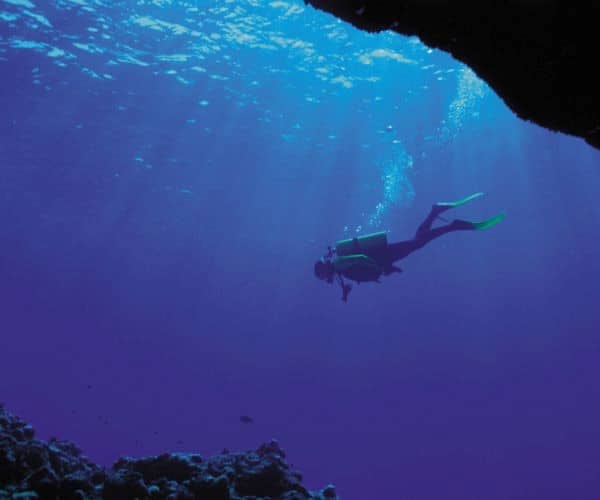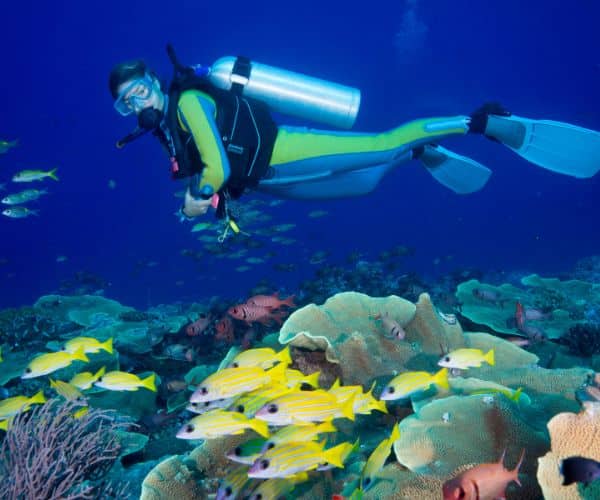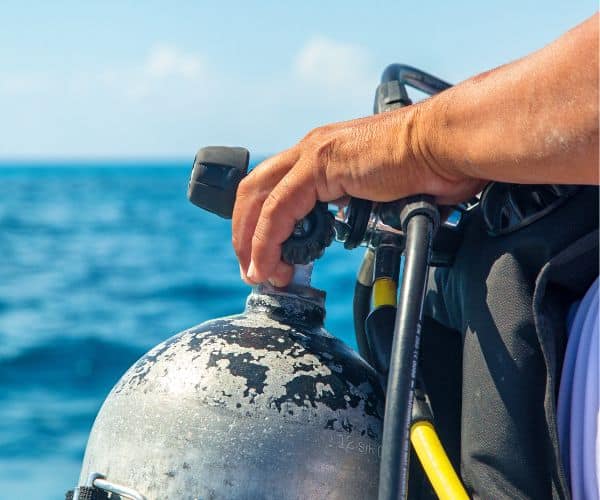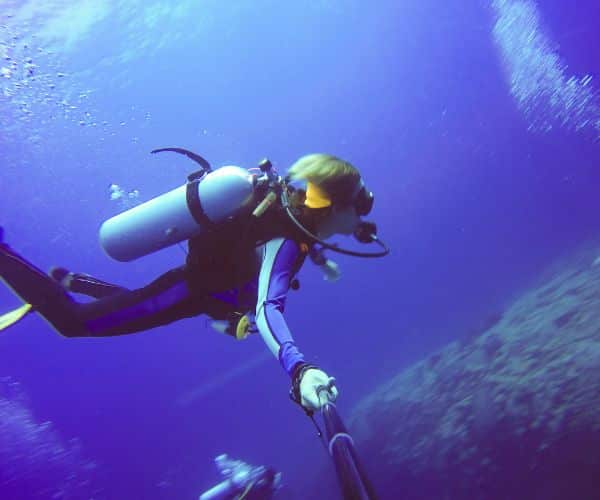Scuba diving is often described as serene – drifting weightlessly in warm water, surrounded by coral and marine life. But the ocean isn’t always still. Currents are part of its natural rhythm, and while some can be gentle and helpful, others can surprise you with strength and unpredictability.
Whether you’re planning a dive in a known current zone or you find yourself caught in a current unexpectedly, understanding how to respond is vital for your safety and confidence. In this guide, we’ll explore how to dive safely in currents, what to do if you’re caught in one, and how to escape challenging conditions like scuba down currents.
Understanding currents in scuba diving
Currents are movements of water created by tides, wind, and underwater geography. They may be lateral (horizontal) or vertical, and they can vary greatly depending on the location, time of day, or even your depth during the dive.
There are several types of currents you might experience as a diver:
Drift currents: Gentle to moderate currents that allow for a relaxed, one-way dive with the water’s flow.
Surge: The back-and-forth motion often felt near the surface due to wave action.
Down currents: Vertical flows of water pushing you deeper – most commonly near walls or drop-offs.
Up currents: The opposite of down currents; they can unexpectedly lift you toward the surface.
Currents aren’t inherently dangerous. In fact, they’re often a sign of a healthy reef system filled with marine life. But diving in them requires preparation and good judgment.
What should you do if you’re caught in a current?

If you’re unexpectedly caught in a strong current, the key is to respond calmly and deliberately. Here’s how to approach the situation:
- Stop, Breathe, Think
First, don’t panic. Take slow, controlled breaths and pause to assess what’s happening. Panicking will increase your air consumption and reduce your ability to react effectively.
- Observe the current
Check your bubbles – are they going straight up or drifting away? This gives you clues about the direction and strength of the current. Also, notice if you’re being pulled down or sideways.
- Signal your buddy
If you’re separated or being pulled in different directions, get your buddy’s attention. Use hand signals or sound devices if needed. Staying together increases safety and makes navigation easier.
- Don’t fight the current
Resist the urge to swim directly against it. This will only tire you out. Instead, swim at a diagonal angle to the current, aiming for calmer water or shelter behind natural features like reef ledges or rocks.
- Control buoyancy
Use small, careful adjustments to stay neutrally buoyant. If the current is vertical, such as a down current, too much air in your BCD could cause a rapid, uncontrolled ascent once you break free.
How to escape a scuba down current

A scuba down current is one of the most unsettling experiences a diver can face. These vertical flows of water can quickly pull you deeper than planned. However, they’re not as dangerous as they feel – as long as you act with control.
If you find yourself in a down current:
- Avoid fully inflating your BCD. It’s tempting, but dangerous. If you escape the current suddenly, you could shoot upward too quickly.
- Swim diagonally away from the wall or drop-off. Most down currents hug vertical surfaces – getting away from the structure usually gets you out of the flow.
- Kick upward at a controlled, steady pace while watching your depth and ascent rate.
- Add air to your BCD in small, gradual increments to regain buoyancy safely.
- Keep an eye on your dive computer. Fast depth changes can affect your no-decompression limits.
Remaining calm is your best tool. The sensation may be frightening, but you have time and options.
Preparing to dive in currents
Most current-related problems can be avoided with proper planning. Before diving in a site known for current, ask yourself:
- What kind of current is expected – drift, surge, or vertical?
- Is this dive within my training and comfort level?
- Do I have the right gear for a current dive?
Recommended equipment for current dives

- DSMB (Delayed Surface Marker Buoy): Essential for surfacing in unexpected locations or during a drift dive.
- Reel or spool: To deploy your DSMB safely from depth.
- Sturdy fins: Preferably with a firm blade for stronger propulsion.
- Streamlined gear setup: Reduce drag by securing loose hoses and accessories.
Physical readiness also matters. Strong finning technique, efficient air consumption, and comfort with buoyancy are especially important when scuba diving in currents.
Should you dive against the current?

One of the most common mistakes divers make is trying to muscle their way through a current. In most cases, it’s not just ineffective – it’s exhausting and dangerous.
Instead of fighting, think strategically:
- Use reef features as breaks. Rest behind coral heads, boulders, or ridges where the current slows.
- Swim at a 45-degree angle to reduce resistance while still progressing.
- Stay low to the seabed or near the reef. Currents tend to be weaker at the bottom than mid-water.
- If you’re losing ground, consider ending the dive with a controlled ascent and DSMB deployment.
It’s better to adapt and retreat than to push through and risk running out of energy or air.
How to dive in a current: practical techniques
Diving in currents doesn’t always mean danger. In fact, many of the world’s best dives are drift dives including Cozumel and Komodo.
When approached correctly, they can be exhilarating.
Here’s how to do it right:
- Enter the water at the right point. Boat captains often drop divers just ahead of the dive site so the current carries them along the reef.
- Stay close to your group. Currents can quickly separate divers who aren’t paying attention.
- Use natural movement. Don’t over-kick. Let the current carry you and adjust only as needed.
- Monitor your air and depth frequently. Currents can cause you to cover more ground and lose track of time.
- Finish with a DSMB deployment. If the current has carried you far, you may not surface near the boat – the DSMB makes you visible.
With practice, you may come to love current diving. It’s like flying underwater.
Real-world scenarios: experts give the following tips on what to do
Let’s look at a few situations and how experts say to handle them.
Scenario 1: You’re caught in a current pulling you away from your buddy.
Don’t swim directly back. Signal them, then work your way across the current in a wide arc, using reef features for cover.
Scenario 2: You’re at a wall and feel yourself descending without kicking.
This is likely a down current. Swim away from the wall and upward at an angle, adding air to your BCD in small bursts.
Scenario 3: You surface far from the boat.
Deploy your DSMB, stay calm, and float while signalling. Stay with your buddy and conserve air. Avoid waving arms or removing gear unless necessary.
Final safety tips for current diving
To close, here are a few practical tips that apply to all current diving – whether you’re dealing with gentle drifts or strong flows:
- Take a drift diving course to build confidence before attempting strong-current sites.
- Practice DSMB deployment in calm conditions so you’re ready when it counts.
- Stay streamlined and compact to reduce resistance.
- Watch your buddy and group closely – separation increases risk.
- Be honest about your limits. If the current looks too strong, sit the dive out.
Choosing the right dive sites for your skill level
Not all dive sites are created equal – and when currents are involved, choosing a site that matches your ability and experience becomes even more critical. Whether you’re a newly certified diver or have hundreds of dives under your belt, being realistic about your comfort level is essential to staying safe and enjoying your time underwater.
How to assess if a dive site is right for you:
- Research the site in advance. Look at dive site maps, read diver reviews, and check local dive operator recommendations. Some sites are known for strong seasonal currents or sudden changes in water movement.
- Ask questions during the dive briefing. Good dive guides will explain the expected conditions, entry and exit strategies, and any known hazards. Don’t hesitate to ask follow-up questions if something is unclear.
- Know your limits. If you’ve only practiced in calm conditions, a fast-moving drift dive may not be the best next step. Instead, build experience gradually with sites that offer moderate currents and plenty of support.
- Buddy up wisely. If possible, pair with a more experienced diver who’s comfortable in current conditions. Their awareness and calm approach can help guide you through unfamiliar situations.
- Consider guided group dives. In areas with tricky currents, diving with a group led by a knowledgeable local guide can make all the difference. They understand the subtleties of the site and know where to find natural protection from the flow.
Dive site examples by current intensity:
- Beginner-friendly: Bonaire (gentle currents, shore dives), Red Sea house reefs (calm and clear).
- Intermediate: Maldives outer reefs (moderate drift), Koh Tao (seasonal currents).
- Advanced: Palau Blue Corner (strong up/down currents), Komodo National Park (powerful drift potential).
Tip: Always be willing to change your plan. Even experienced divers sometimes call off dives when conditions feel “off.” Safety should always outweigh pride or pressure.
Dive with confidence
Currents are part of the ocean’s character. They bring nutrients, life, and motion to the underwater world. With knowledge, training, and a calm mindset, scuba diving in currents can be just as safe – and even more thrilling – than still-water dives.
So, if you ever find yourself scuba caught in a current, remember don’t fight the ocean. Flow with it, understand it, and respond with control. That’s what turns a stressful dive into a skilful one – and a nervous diver into a confident explorer.
Protect your underwater adventures with specialist scuba diving insurance from SportsCover Direct
Scuba diving comes with its own set of unique challenges and risks. Whether you’re exploring remote reefs or testing your limits in open water, having reliable scuba diving travel insurance is a smart move to safeguard your experience.
SportsCover Direct offers tailored Scuba Diving Travel Insurance designed to give you peace of mind wherever your diving journey takes you. Our flexible global cover options cater to divers of all levels and include features like emergency medical assistance, cover for pre-existing conditions, trip cancellation, and protection for dives to depths of 40 metres or more. Choose from single or multi-trip policies that fit your travel plans.
Discover more about our Scuba Diving Travel Insurance and get a quote that suits your specific needs. Our friendly, knowledgeable team is always ready to help with any questions you may have.
This blog has been created as general information and should not be taken as advice. Make sure you have the correct level of insurance for your requirements and always review policy documentation.